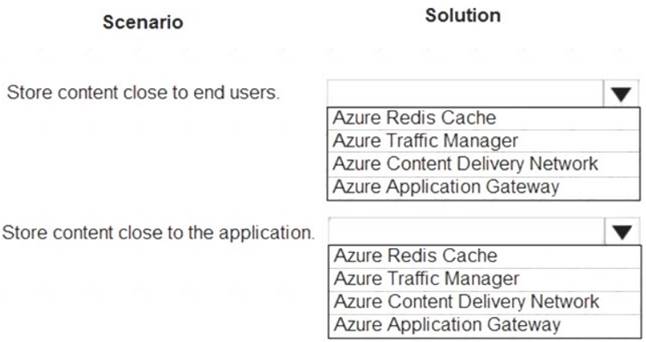- (Exam Topic 5)
You have an Azure subscription that contains a Windows Virtual Desktop tenant. You need to recommend a solution to meet the following requirements: Start and stop Windows Virtual Desktop session hosts based on business hours.
Start and stop Windows Virtual Desktop session hosts based on business hours.  Scale out Windows Virtual Desktop session hosts when required.
Scale out Windows Virtual Desktop session hosts when required. Minimize compute costs.
Minimize compute costs.
What should you include in the recommendation?
Correct Answer:
C
Reference:
https://www.ciraltos.com/automatically-start-and-stop-wvd-vms-with-azure-automation/ https://wvdlogix.net/windows-virtual-desktop-host-pool-automation-2
https://getnerdio.com/academy/how-to-optimize-windows-virtual-desktop-wvd-azure-costs-with-event-based-au
- (Exam Topic 5)
Your company deploys an Azure App Service Web App.
During testing the application fails under load. The application cannot handle more than 100 concurrent user sessions. You enable the Always On feature. You also configure auto-scaling to increase counts from two to 10 based on HTTP queue length.
You need to improve the performance of the application.
Which solution should you use for each application scenario? To answer, select the appropriate options in the answer area.
NOTE: Each correct selection is worth one point.
Solution:
Graphical user interface, text Description automatically generated with medium confidence
Box 1: Content Delivery Network
A content delivery network (CDN) is a distributed network of servers that can efficiently deliver web content to users. CDNs store cached content on edge servers in point-of-presence (POP) locations that are close to end users, to minimize latency.
Azure Content Delivery Network (CDN) offers developers a global solution for rapidly delivering
high-bandwidth content to users by caching their content at strategically placed physical nodes across the world. Azure CDN can also accelerate dynamic content, which cannot be cached, by leveraging various network optimizations using CDN POPs. For example, route optimization to bypass Border Gateway Protocol (BGP).
Box 2: Azure Redis Cache
Azure Cache for Redis is based on the popular software Redis. It is typically used as a cache to improve the performance and scalability of systems that rely heavily on backend data-stores. Performance is improved by temporarily copying frequently accessed data to fast storage located close to the application. With Azure Cache for Redis, this fast storage is located in-memory with Azure Cache for Redis instead of being loaded from disk by a database.
References:
https://docs.microsoft.com/en-us/azure/azure-cache-for-redis/cache-overview
Does this meet the goal?
Correct Answer:
A
- (Exam Topic 5)
You have an Azure subscription that is linked to an Azure Active Directory Premium Plan 2 tenant The tenant has multi-factor authentication (MFA) enabled for all users.
You have the named locations shown in the following table.
You have the users shown in the following table.
You plan to deploy the Conditional Access policies shown in the following table.
For each of the following statements, select Yes if the statement is true. Otherwise, select No.
NOTE: Each correct selection is worth one point.
Solution:
A screenshot of a computer Description automatically generated with medium confidence
Does this meet the goal?
Correct Answer:
A
- (Exam Topic 5)
You are developing a sales application that will contain several Azure cloud services and will handle different components of a transaction. Different cloud services will process customer orders, billing, payment, inventory, and shipping.
You need to recommend a solution to enable the cloud services to asynchronously communicate transaction information by using REST messages.
What should you include in the recommendation?
Correct Answer:
A
Service Bus is a transactional message broker and ensures transactional integrity for all internal operations against its message stores. All transfers of messages inside of Service Bus, such as moving messages to a dead-letter queue or automatic forwarding of messages between entities, are transactional.
Reference:
https://docs.microsoft.com/en-us/azure/service-bus-messaging/service-bus-transactions
" Service Bus offers a reliable and secure platform for asynchronous transfer of data and state." ... "Service Bus supports standard AMQP 1.0 and HTTP/REST protocols."
https://docs.microsoft.com/en-us/azure/service-bus-messaging/service-bus-messaging-overview
- (Exam Topic 5)
You need to design a highly available Azure SQL database that meets the following requirements:  Failover between replicas of the database must occur without any data loss.
Failover between replicas of the database must occur without any data loss. The database must remain available in the event of a zone outage.
The database must remain available in the event of a zone outage.  Costs must be minimized
Costs must be minimized
Which deployment option should you use?
Correct Answer:
C

